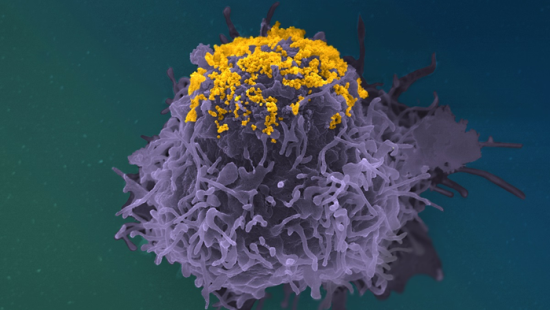
|
PRESS RELEASE | 2022.02.02
NEW ANTI-HIV ANTIBODY FUNCTION DISCOVERED: TETHERING OF VIRAL PARTICLES AT THE SURFACE OF CELLS

HIV particles (in yellow) accumulating on the surface of an infected cell (in purple). Colorized scanning electron microscopy image.
CREDIT: © Stéphane Fremont, Jérémy Dufloo, Arnaud Echard, Timothée Bruel, Olivier Schwartz, Jean-Marc Panaud, Institut Pasteur
Teams at the Institut Pasteur, CNRS, Vaccine Research Institute (VRI) and Université de Paris have discovered a new function of anti-HIV-1 antibodies by applying cutting-edge microscopy techniques to in vitro viral cultures. The scientists found that certain antibodies already known for effectively targeting HIV-1 envelope (Env) protein can prevent infected cells from releasing viral particles, thus halting viral spread. The antibodies are Y-shaped, enabling them to attach themselves between the infected cell and viral particles or directly between viral particles. This chain composed of antibodies and viral particles prevents viral spread. These findings demonstrate that these powerful antibodies exhibit different antiviral activities in addition to neutralization. The study is published in the February 2, 2022 issue of Nature Communications.
Broadly neutralizing antibodies (bNAbs) targeting virus envelope (Env) protein have significant potential for treating HIV-1. They were initially identified in rare cases of patients whose serum was capable of inhibiting numerous HIV strains. These antibodies exhibit multiple antiviral activities. As well as neutralizing the virus, i.e. preventing it from infecting new cells, they also kill infected cells. Consequently, they are referred to as polyfunctional molecules. It is necessary to fully understand the scope of these antiviral activities in order to use existing antibodies more effectively or refine the selection criteria for new antibodies. It is moreover useful to further investigate the polyfunctionality of anti-HIV-1 antibodies in order to improve our understanding of the role played by antibodies and thus tackle other viral infections.
Initially, teams at the Institut Pasteur, CNRS, VRI and Université de Paris sought to determine whether antibodies were capable of preventing infected cells from producing viral particles. To that end, they cultured CD4 T cells (HIV's natural target) in vitro with various antibodies for 24 hours. They subsequently measured the quantity of viral particles produced by the cells in the culture medium and the quantity of viral particles remaining in the cells. As a result of these experiments, the scientists were able to demonstrate that certain antibodies increased virus quantity in cells but reduced it in the culture medium. This intriguing finding led them to believe that certain antibodies impeded the release of viral particles without preventing their production.
To test this theory, the scientists used various microscopy techniques to observe cells' production of viral particles. They initially examined the cells by fluorescence microscopy, a technique used to differentiate virus proteins. This enabled them to demonstrate that infected cells accumulate large quantities of mature viral protein. This finding suggests that full viral particles accumulate in cells. To determine the precise location of these viral particles, the scientists subsequently used scanning electron microscopy to observe the surface of infected cells. "Using this method, we observed that these antibodies (bNAbs) prompt an accumulation of viral particles at the surface of cells, forming clusters and highly atypical structures (see illustration)," comments Timothée Bruel, co-last author of the study and scientist in the Virus and Immunity Unit at the Institut Pasteur.
Next, the scientists combined a transmission electron microscopy technique with immunogold labeling. This enabled them to demonstrate that antibodies interpose themselves between viral particles and the infected cell, forming a chain cluster. Experiments with mutant antibodies subsequently demonstrated that the antibodies' Y shape creates this clustered structure. Their arms are capable of linking two viruses, or one virus to the infected cell membrane, and their attachment points are sufficiently strong to prompt this phenomenon.
"We have demonstrated that only the most powerful antibodies tether viral particles at the surface of infected cells. Trapped viral particles can no longer infect new cells," concludes Olivier Schwartz, co-last author of the study and Head of the Virus and Immunity Unit at the Institut Pasteur.
[1] HIV-1 is the pandemic form of the human immunodeficiency virus. The other less common type is HIV-2.
[2] This is named the "Virology Unit" at the CNRS (CNRS/Institut Pasteur).
Source
Broadly neutralizing anti-HIV-1 antibodies tether viral particles at the surface of infected cells, Nature Communications, February 2, 2022
Jérémy Dufloo1,2, Cyril Planchais3, Stéphane Frémont4, Valérie Lorin3, Florence Guivel-Benhassine1, Karl Stefic5, Nicoletta Casartelli1, Arnaud Echard4, Philippe Roingeard6, Hugo Mouquet3, Olivier Schwartz1,7,* and Timothée Bruel1,7,*
1 Institut Pasteur, Université de Paris, CNRS UMR3569, Virus and Immunity Unit, 75015 Paris, France
2 Université de Paris, École doctorale BioSPC 562, 75013 Paris, France
3 Institut Pasteur, Université de Paris, INSERM U1222, Humoral Immunology Laboratory, 75015 Paris, France
4 Institut Pasteur, Université de Paris, CNRS UMR3691, Membrane Traffic and Cell Division Unit, 75015 Paris, France
5 CHRU de Tours, Hôpital Bretonneau, Service de Bactériologie-Virologie, 37000 Tours, France.
6 Université de Tours, CHRU de Tours, INSERM U1259 MAVIVH and Plateforme IBiSA de Microscopie Électronique, 37000 Tours, France
7 Vaccine Research Institute, 94000 Créteil, France
###
Contact
Myriam Rebeyrotte
Service de Presse - Press Office
Institut Pasteur
25-28 rue du docteur Roux
75724 Paris cedex 15
tel : + 33 (0)1 45 68 81 01
Source: https://www.pasteur.fr/en/press-area/press-documents/new-anti-hiv-antibody-function-discovered-tethering-viral-particles-surface-cells
"Reproduced with permission - Institut Pasteur"
Institut Pasteur
For more HIV and AIDS News visit...
Positively Positive - Living with HIV/AIDS:
HIV/AIDS News |